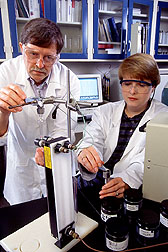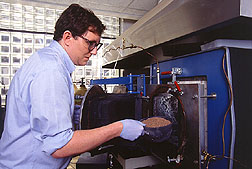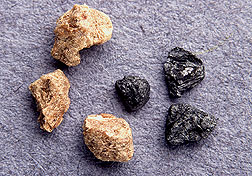Some "Trash-Talk" Worth Listening to—Activated Carbons in a Nutshell
A new kind of recycling is under way in the Commodity Utilization Research Unit located at the Southern Regional Research Center (SRRC) just outside downtown New Orleans. But don't expect to find crushed soda cans, plastic water bottles, or musty-smelling newspapers heaped at this high-tech facility.
A team of chemists there led by Wayne E. Marshall is recycling trash of the agricultural kind—like discarded soybean hulls and the shells of various edible nuts.
About 50 million tons of these and other assorted agricultural wastes are generated each year.
The pecan industry, for example, generates about 59,500 tons of shells from its harvests. Growers and processors absorb some of the cost of shell disposal by grinding them up and selling them as livestock bedding, mulch, or other low-value commodities.
The shells alone bring in a pittance: about $2 a ton. But Marshall's group is on the verge of delivering what could amount to an economic boom. Since 1993, they have been perfecting an array of techniques to make charcoal-like substances called activated carbons from pecan, almond, and most recently, macadamia nut shells.
"We're looking at creating new uses and value-added products from these commodities," says Lynda H. Wartelle. She and Marshall are with USDA's Agricultural Research Service. Their waste-recycling unit is operated by the SRRC.
Today's usual activated carbons are made from coal, peat, coconut shells, and wood, says Marshall. Working like charcoal "sponges," they adsorb from the air or water many types of organic compounds—like benzene, toluene, and acetonitrile, as well as metals such as lead.
|
|
Carbon uses run the gamut: from fish tank filters and tap water purifiers to wastewater treatment and air pollution monitoring and control.
In the United States, such applications consume over 300 million pounds of activated carbons annually—about half the 600 million pounds used worldwide.
"One of the selling points for this approach is that we're looking to make use of very low-value agricultural wastes. In this case, we're using a waste to clean up other wastes," says Christopher A. Toles, formerly with ARS but now with Northeastern University in Boston, Massachusetts. "And the nutshells we're working with are renewable on a yearly basis."
The team, looking to collaborate with industry, recently negotiated a cooperative agreement with a Georgia-based firm to test granular forms of the nutshell carbons.
Their work has also sparked interest from commercial nut growers and trade groups like the Almond Hullers and Processors Association. Under a special grant, that California-based organization supplies the scientists with large amounts of shells for their research.
The team sees other potential avenues for their emerging technology: electroplating companies, mining operations, and jewelry makers. All are industries that use activated carbons to help remove contaminants in the wastewater they generate.
A Tough Nut To Crack
Marshall's team is now testing activated carbons made from macadamia shells supplied to them by a Hawaiian nut processor.
The shells derive their density and strength from two components—lignin and cellulose. Density and strength are key to the shell's conversion to carbons. That's because they must withstand grinding and exposure to temperatures of up to 900 oC in combination with steam, certain gases, or acids.
Such treatment activates, or opens, millions of microscopic pores in the carbonized shells, enabling them to hold onto chemical molecules like benzene. Another step, called oxidation, confers a negative charge to the shells that helps capture metal ions, such as those in solution.
So porous are today's activated carbons, notes Toles, that a single gram can have over 900 square meters of surface area. A pound can have up to 465,000 square meters—owing to the materials' micro-, meso-, and macro-sized pores.
Of the nutshell carbons examined thus far, macadamias adsorb the broadest range of organic molecules. "We're still trying to figure out what makes the macadamia's nutshell carbons so effective in this regard," says Wartelle. She also compares the nutshell carbons to commercial organic adsorbents made from natural and synthetic materials.
|
|
Chalk It Up to Charcoal
In one comparative study with six commercial adsorbents, use of activated macadamia shells led to a three- to fourfold increase in the ability of a standard Environmental Protection Agency air sampling procedure to detect benzene at concentrations of 100 parts per billion. Benzene is used in fuels, dyes, solvents, and many other products but becomes a contaminant upon escape into the environment.
The nutshell carbon also worked well in small-scale studies to remove copper from industrial wastewater.
Wartelle is particularly encouraged by the carbon's potential as an adsorbent material for gas chromatographic analysis of air.
Right now, the cost for such analytical carbons can run as high as $13 per gram, she reports. Eventually, the macadamia shells might supplement this specialty market.
"We also hope to do more work with some of the other harder nutshells, like those of hazelnuts, black walnuts, and Brazil nuts, and to try to investigate the properties that make them a good air sampling carbon," says Wartelle.
Nut Just a Pipe Dream
|
|
To foster commercial collaboration, the team has applied for patent protection on its activation procedures. Use of these methods, Toles estimates, could yield about 3,000 tons of activated carbon material from the 14,600 tons of macadamia shells now available.
Marshall stresses that the idea is to supplement—not displace—existing carbon resources.
"Coal and coconut shells are two really big resources," Toles says. "But when you make carbons from coal, you're competing with people who use it for energy."
Coal also generates considerable ash and sulfur. But the nutshells, when activated, release very little. "We're hoping that making activated carbons from nutshells will create a slightly 'greener' technology than making them from coal," Toles says.
And like many standard commercial carbon products, Wartelle adds, "the nutshell carbons can be used over and over again for laboratory sampling."
The same properties that make the nutshell carbons so promising for industrial cleanup might also lend themselves to more mundane applications, like purifying tap water.
"Ultimately," says Toles, "we think it might be interesting to devise a taste and odor nutshell carbon to supplement charcoal carbons already on the market for water purification."
Now, that's not such a nutty idea.—By Jan Suszkiw, Agricultural Research Service Information Staff.
This research is part of New Uses, Quality, and Marketability of Plant Products, an ARS National Program described on the World Wide Web at http://www.nps.ars.usda.gov/programs/cppvs.htm.
Wayne E. Marshall and Lynda H. Wartelle are in the USDA-ARS Commodity Utilization Research Unit, Southern Regional Research Center, 1100 Robert E. Lee Blvd., New Orleans, LA 70124; phone (504) 286-4207, fax (504) 286-4367.
"Some 'Trash-Talk' Worth Listening to—Activated Carbons in a Nutshell" was published in the September 1999 issue of Agricultural Research magazine.










